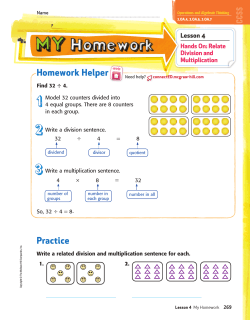
Eureka Math Parent Guide (4th Grade)
Eureka Math Parent Guide A GUIDE TO SUPPORT PARENTS AS THEY WORK WITH THEIR STUDENTS IN MATH. GRADE FOCUS Fourth grade mathematics is about (1) developing understanding and fluency with multi-digit multiplication and division; (2) developing an understanding of fraction equivalence, addition and subtraction of fractions with like denominators, and multiplication of fractions by whole numbers; and (3) understanding that geometric figures can be analyzed and classified based on their properties, such as having parallel sides, perpendicular sides, particular angle measures, and symmetry. • Module 1: Place Value, Rounding, and Algorithms for Addition and Subtraction GRADE 4 MODULE 3 • Multiply a whole number of up to four digits by a one-digit whole number, and multiply two two-digit numbers, using strategies based on place value and the properties of operations. • Apply the area and perimeter formulas for rectangles in real world and mathematical problems. For example, find the width of a rectangular room given the area of the flooring and the length, by viewing the area formula as a multiplication equation with an unknown factor. TOPIC OVERVIEW • Module 2: Unit Conversions and Problem Solving with Metric Measurement Topics are the lessons within a module that help children master the skills above. Here are the lessons that will guide your child through Module 3: » Module 3: Multi-Digit Multiplication and Division • Topic A: Multiplicative Comparison Word Problems • Module 4: Angle Measure and Plane Figures • Topic B: Multiplication by 10, 100, and 1,000 • Module 5: Fraction Equivalence, Ordering, and Operations • Topic C: Multiplication of up to Four Digits by SingleDigit Numbers • Module 6: Decimal Fractions • Topic D: Multiplication Word Problems • Module 7: Exploring Multiplication • Topic E: Division of Tens and Ones with Successive Remainders LET’S CHECK IT OUT! MODULE 3 FOCUS In this module, we will start with applying multiplication and division to contexts such as area and perimeter to set the stage for multiplication and division of multi-digit whole numbers. We will practice various ways to model these problems, moving from concrete to abstract. MORE SPECIFICALLY, CHILDREN WILL LEARN HOW TO: • Interpret a multiplication equation as a comparison, e.g., interpret 35 = 5 × 7 as a statement that 35 is 5 times as many as 7 and 7 times as many as 5. • Multiply or divide to solve word problems involving multiplicative comparison, e.g., by using drawings and equations with a symbol for the unknown number to represent the problem. • Solve multistep word problems using addition, subtraction, multiplication and division, including problems in which remainders must be interpreted. Assess the reasonableness of answers using mental computation and estimation strategies including rounding. • Find all factor pairs for a whole number in the range 1-100. Recognize that a whole number is a multiple of each of its factors. • Topic F: Reasoning with Divisibility • Topic G: Division of Thousands, Hundreds, Tens, and Ones • Topic H: Multiplication of Two-Digit by Two-Digit Numbers WORDS TO KNOW • Number Properties » Associative Property: 3 × (4 × 8) = (3 × 4) × 8 » Distributive Property: 6 × (3 + 5) = (6 × 3) + (6 × 5) » Partial Product: 24 × 6 = (20 × 6) + (4 × 6) • Mathematical Terms » Prime Number: positive integer only having factors of one and itself » Composite Number: positive integer having three or more factors » Divisor: the number by which another number is divided » Remainder: the number left over when one integer is divided by another • Algorithm: steps for base ten computations with the four operations • Area: the amount of two-dimensional space in a bounded region • Perimeter: length of a continuous line around a geometric figure SAMPLE PROBLEMS SAMPLE 1 Students will learn how to determine if a number is prime or composite by looking for factor pairs in the number. SAMPLE 2 Students began in earlier grades to build arrays, showing multiplication and division as a series of rows and columns. In 4th grade, they learn to show these types of problems as an area model. As students move through the grades, the area model will be a powerful tool that can take them all the way into algebra and beyond. One of the goals in A Story of Units is to first give students concrete experiences with mathematical concepts, and then build slowly toward more abstract representations of those concepts. The area model is a tool that helps students to make that important leap. The area model encourages students to think about each part of a number as they multiply. Thus, 34 x 26 becomes a series of partial products: 4 x 6 24 4 x 20 80 30 x 6 180 + 30 x 20 600 884884 HOW YOU CAN HELP AT HOME • Become familiar with the area model, a different method of multiplying than you may have learned. • Continue to review the place value system with your child. • Discuss mathematical patterns, such as 5 x 9, 5 x 90, 50 x 90, 50 x 900, etc.
© Copyright 2025





















